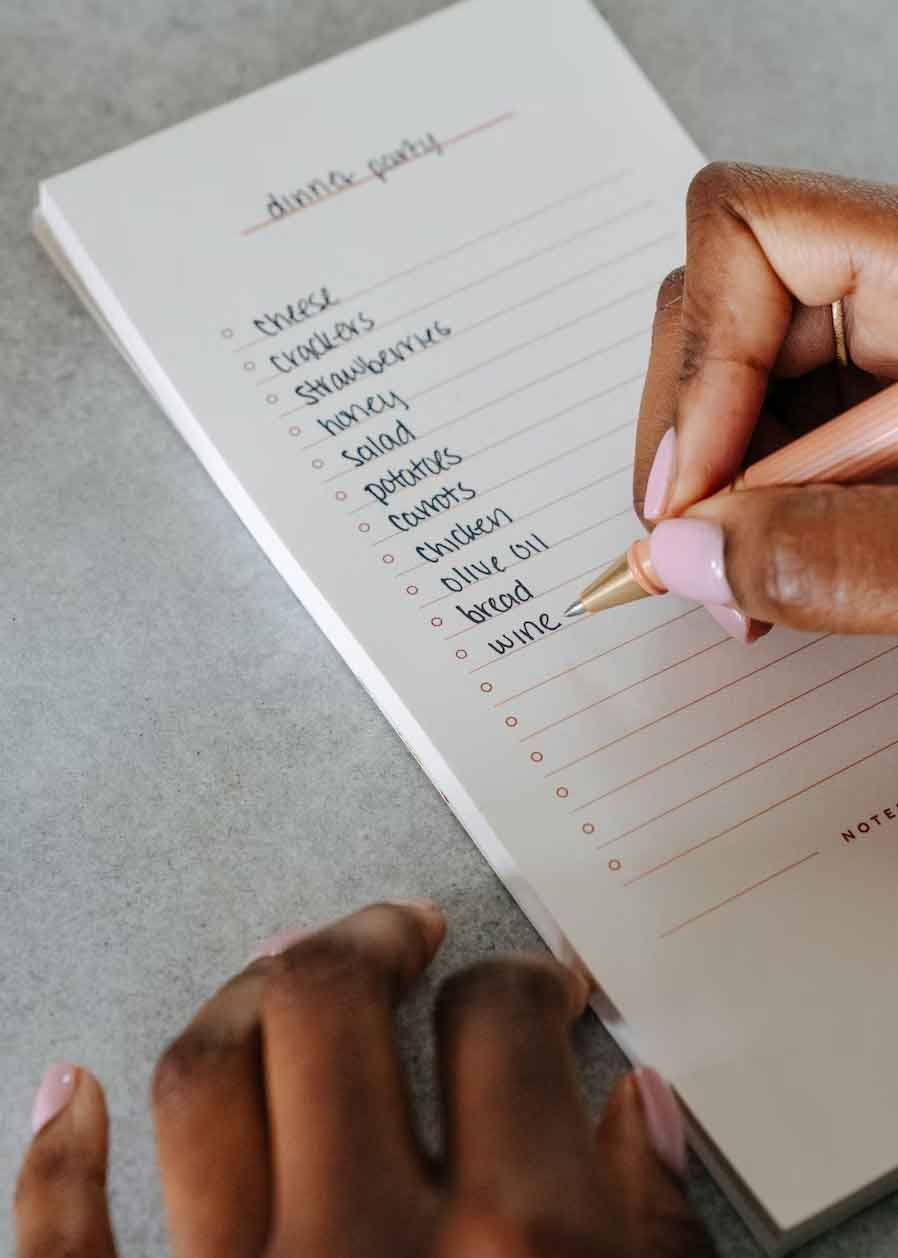Here's a step-by-step guide on how to create a food shopping list:
Plan your meals: Start by planning your meals for the upcoming week. Consider breakfast, lunch, dinner, and any snacks or special occasions. Take into account your dietary preferences, any specific recipes you want to try, and the number of servings needed for each meal.
Take inventory: Check your pantry, refrigerator, and freezer to see what ingredients you already have on hand. Make note of any items that are running low or need to be replenished.
Categorise your list: Organise your shopping list into different categories to make your trip to the grocery store more efficient. Common categories include fruits and vegetables, dairy, meat and seafood, pantry staples, condiments, and household items. Adjust the categories based on your personal preferences and the layout of your grocery store.
Write it down: Use a pen and paper, a notepad app on your phone, or a dedicated shopping list app to write down the items you need. List each item under the appropriate category.
Be specific: When writing down items, be specific about quantities and details. For example, instead of writing "vegetables," specify which vegetables you need, such as carrots, broccoli, or spinach. Include quantities or approximate amounts to ensure you buy the right quantities.
Consider meal ingredients: Review your planned meals and add any missing ingredients to your shopping list. This includes spices, herbs, specific types of sauces, or any other ingredients needed for your recipes.
Think about staples: Don't forget to include everyday staples that you use regularly, such as milk, bread, eggs, cooking oil, or your favourite snacks.
Check for discounts and coupons: Before finalising your list, check for any discounts or coupons that can help you save money. Browse weekly ads, online deals, or any loyalty programs offered by your grocery store.
Review and finalise: Once you have completed your list, take a moment to review it and make sure you haven't missed anything. Consider the quantities and double-check if you have included all the necessary items.
Shop smart: When you go shopping, stick to your list as closely as possible to avoid impulse buying. Keep your list handy, cross off items as you put them in your cart, and stay focused on your intended purchases.
By following these steps, you can create a comprehensive food shopping list that will make your trips to the grocery store more organized and efficient.
Smart food shopping habits play a crucial role in maintaining a healthy lifestyle while being mindful of our budget.
Food shopping lists are essential for several reasons:
Organisation: Shopping lists help you stay organised and focused while grocery shopping. They serve as a reminder of what items you need to purchase, preventing you from forgetting important ingredients or items.
Time and Money Saving: With a shopping list, you can plan your meals in advance and buy only the necessary items. This helps you avoid impulse buying and unnecessary purchases, ultimately saving you both time and money.
Healthy Eating: A well-thought-out shopping list enables you to prioritise healthy food choices. By including nutritious items like fruits, vegetables, lean proteins, and whole grains on your list, you can ensure you're selecting a well-balanced variety of foods.
Avoiding Food Waste: When you have a shopping list, you can buy the exact quantities of ingredients you need for your meals. This reduces the chances of buying excess food that may go to waste. By minimising food waste, you're not only saving money but also reducing your environmental impact.
Efficiency: Shopping lists can make your grocery shopping trips more efficient. By organising your list according to the store layout or specific sections, you can navigate the aisles more quickly, reducing the time spent searching for items.
Meal Planning: A shopping list goes hand in hand with meal planning. By creating a list of necessary ingredients for your planned meals, you can ensure you have everything you need on hand when it's time to cook. This can simplify meal preparation and reduce stress.
Dietary Restrictions and Allergies: If you have specific dietary restrictions or food allergies, a shopping list becomes even more important. It helps you identify suitable alternatives and ensures you don't accidentally purchase items that could be harmful or cause discomfort.
In summary, shopping lists provide organisation, save time and money, promote healthy eating, minimise food waste, increase efficiency, aid in meal planning, and accommodate dietary restrictions and allergies. Incorporating a shopping list into your routine can greatly enhance your overall grocery shopping experience.










